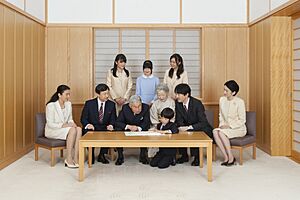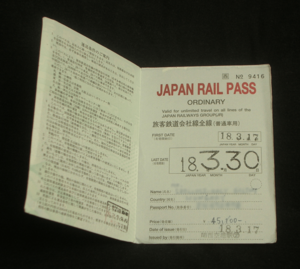Heisei era facts for kids
| January 8, 1989 – April 30, 2019 | |
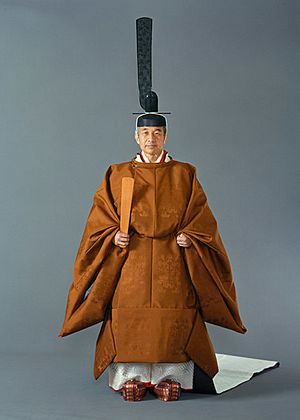
Emperor Akihito of the Heisei era (1990)
|
|
| Preceded by | Shōwa |
|---|---|
| Including |
Major events
Japanese asset price bubble
Recruit scandal 1995 Kobe earthquake Tokyo subway sarin attack Kyoto Protocol 2011 Tōhoku earthquake and tsunami Fukushima Daiichi nuclear disaster |
| Followed by | Reiwa |
| Monarch | Akihito |
The Heisei era (pronounced Hey-say) was a special time in Japanese history. It lasted from January 8, 1989, to April 30, 2019. This period was named after Emperor Akihito's reign. He was the 125th Emperor of Japan.
The Heisei era began the day after Emperor Hirohito passed away. His son, Akihito, then became the new Emperor. In Japan, when an Emperor passes away, they are given a new name. So, Hirohito was later called "Emperor Shōwa."
The year 1989 was unique. It was the 64th year of the Shōwa era until January 7. Then, from January 8 onwards, it became the first year of the Heisei era. The Heisei era ended when Emperor Akihito decided to step down from his role. After him, his son, Naruhito, became the new Emperor, starting the Reiwa era.
Contents
What Was the Heisei Era?
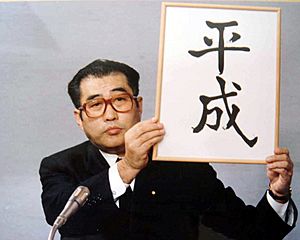
On January 7, 1989, Japan's Imperial Household Agency announced that Emperor Hirohito had passed away. Soon after, Keizō Obuchi, who was a top government official and later became Prime Minister, announced the end of the Shōwa era. He then shared the new name for the next era: "Heisei."
The Meaning of "Heisei"
The name "Heisei" comes from two old Chinese books. These books are about history and philosophy. One book, Records of the Grand Historian, talks about a wise ruler. It has a phrase that means "peace inside and success outside."
The other book, Book of Documents, has a phrase that means "peace on heaven and earth." By putting these ideas together, "Heisei" means "peace everywhere." This new era name started right after Emperor Akihito became Emperor on January 7, 1989.
Emperor Akihito Steps Down
In 2016, Emperor Akihito spoke to the nation on TV. He shared his worry that his age might stop him from doing his duties. This hinted that he wanted to retire. In 2017, the Japanese government passed a law to allow him to step down.
Then, in 2019, Prime Minister Shinzō Abe announced that Emperor Akihito would retire on April 30, 2019. The very next day, his son Naruhito became Emperor, and the Reiwa era began.
Big Events During the Heisei Era
The Heisei era saw many important changes and events in Japan.
Economy and Politics
The Heisei era began with a strong economy in Japan. But soon, the "bubble economy" burst. This meant that prices for things like property and stocks, which had been very high, suddenly dropped. Japan then went through a period called the "Lost Decade." During this time, the economy grew very slowly, and prices often went down.
Politically, the Liberal Democratic Party (LDP) had been in power for a long time. But in 1993, they were voted out. However, the new government didn't last long, and the LDP came back into power in 1994.
Pop Culture Boom
The 1990s was a huge time for Japanese pop culture, especially anime. Many popular anime shows and characters became famous around the world. Some examples include Pokémon, Hello Kitty, Sailor Moon, Dragon Ball, and Gundam. These shows and characters are still loved by many people today.
Natural Disasters and Safety
In 1995, a big earthquake hit Kobe. This was a very serious event. Also in 1995, there were sarin gas attacks on the Tokyo Metro subway system. These events showed that Japan needed better ways to respond to emergencies. This led to more non-government organisations (NGOs) helping out in Japan.
A very important international agreement, the Kyoto Protocol, was signed in Kyoto, Japan, in 1997. This treaty aimed to reduce greenhouse gas emissions around the world.
On March 11, 2011, Japan was hit by a massive earthquake and tsunami. It was the strongest earthquake ever recorded in Japan's history. The tsunami caused huge waves that flooded many coastal areas. This disaster also led to serious problems at the Fukushima Daiichi Nuclear Power Plant. It was a very difficult time for the country. After this, Emperor Akihito spoke to the nation on TV, which was a rare event.
Japan's Role in the World
During the Heisei era, Japan started to play a bigger role in global safety. In 1991, Japan gave a lot of money to help with the Gulf War. Later, Japanese ships helped clear sea mines in the Persian Gulf.
In 2003, Japan sent soldiers to Iraq to help with rebuilding efforts. This was the biggest overseas troop deployment since World War II.
Japan also co-hosted the 2002 FIFA World Cup with South Korea. This was the first time the World Cup was held in Asia.
Space and Technology
In 2005, Japan's space agency, JAXA, sent a robotic spacecraft called Hayabusa to an asteroid. It collected tiny samples and brought them back to Earth in 2010. This was the first time a spacecraft landed on an asteroid and returned samples.
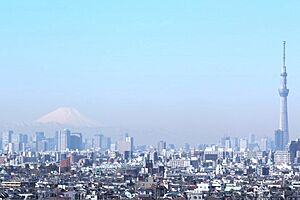
In 2011, the Tokyo Skytree was completed. It became the tallest tower in the world at 634 meters (2,080 feet). It is the second tallest structure in the world after the Burj Khalifa.
Population and Tourism
Japan's population reached its highest point of 128 million people in 2010. After that, it started to decline because of a low birthrate.
By 2018, a record number of over 31 million foreign tourists visited Japan. Many of these tourists came from South Korea, China, Taiwan, and Hong Kong.
Sports and Achievements
In 2018, Naomi Osaka made history. She became the first Japanese woman to win a Grand Slam singles tennis title at the US Open.
Economy in Heisei
The Heisei era started with a very strong economy in Japan, often called a "bubble economy." However, this bubble burst, leading to a period of slow economic growth and falling prices. This time is known as the "Lost Decade."
During the Heisei era, the world's biggest companies changed a lot. In 1989, many of the top companies by market value were Japanese. But by 2019, most of the biggest companies were from the United States or China.
- Top 10 Companies by Market Value
| Rank | First year of Heisei (1989) | Last year of Heisei (2019) |
|---|---|---|
| 1 | US$163.8 billion |
US$940.8 billion |
| 2 | US$71.5 billion |
US$895.6 billion |
| 3 | US$69.5 billion |
US$874.7 billion |
| 4 | US$67.0 billion |
US$818.1 billion |
| 5 | US$66.0 billion |
US$493.7 billion |
| 6 | US$64.6 billion |
US$475.7 billion |
| 7 | US$59.2 billion |
US$472.9 billion |
| 8 | US$54.9 billion |
US$440.9 billion |
| 9 | US$54.4 billion |
US$372.2 billion |
| 10 | US$54.3 billion |
US$342.1 billion |
Heisei Year Conversion
In Japan, years are often counted based on the Emperor's reign. To find the Heisei year from a regular calendar year (between 1989 and 2019), you just subtract 1988 from the year. For example, 1989 minus 1988 is Heisei 1.
| Heisei | 1 | 2 | 3 | 4 | 5 | 6 | 7 | 8 |
|---|---|---|---|---|---|---|---|---|
| I | II | III | IV | V | VI | VII | VIII | |
| AD | 1989 | 1990 | 1991 | 1992 | 1993 | 1994 | 1995 | 1996 |
| MCMLXXXIX | MCMXC | MCMXCI | MCMXCII | MCMXCIII | MCMXCIV | MCMXCV | MCMXCVI | |
| Heisei | 9 | 10 | 11 | 12 | 13 | 14 | 15 | 16 |
| IX | X | XI | XII | XIII | XIV | XV | XVI | |
| AD | 1997 | 1998 | 1999 | 2000 | 2001 | 2002 | 2003 | 2004 |
| MCMXCVII | MCMXCVIII | MCMXCIX | MM | MMI | MMII | MMIII | MMIV | |
| Heisei | 17 | 18 | 19 | 20 | 21 | 22 | 23 | 24 |
| XVII | XVIII | XIX | XX | XXI | XXII | XXIII | XXIV | |
| AD | 2005 | 2006 | 2007 | 2008 | 2009 | 2010 | 2011 | 2012 |
| MMV | MMVI | MMVII | MMVIII | MMIX | MMX | MMXI | MMXII | |
| Heisei | 25 | 26 | 27 | 28 | 29 | 30 | 31 | |
| XXV | XXVI | XXVII | XXVIII | XXIX | XXX | XXXI | ||
| AD | 2013 | 2014 | 2015 | 2016 | 2017 | 2018 | 2019 | |
| MMXIII | MMXIV | MMXV | MMXVI | MMXVII | MMXVIII | MMXIX |
See also
 In Spanish: Era Heisei para niños
In Spanish: Era Heisei para niños
- 1989 in Japan
- 1990s in Japan
- 2000s in Japan
- 2010s in Japan


